Do Warts & Moles Affect a Dog’s Health?
Wart Risks
Warts are passed from dog-to-dog when an uninfected dog comes in contact with an infected dog or catches the virus in the infected dog’s environment. Warts, or viral papillomas, usually are harmless with little to no impact on a dog’s health. If your dog has a large number of oral papillomas, eating and drinking can cause significant pain and lead to malnourishment. There are only two published cases where warts have developed into cancer, according to Veterinary Partner. Oral papillomas have an increased risk of infection due to bacteria of the mouth.
Changing Moles
Moles are caused by an uncontrollable development of cells. As with human moles, most moles on dogs are harmless. Cancerous moles often have irregular borders and occasionally bleed, but even benign moles can look suspicious. Some moles have a cauliflower appearance that resembles warts, but actually are skin carcinomas. Melanoma typically develops from an older mole, so it’s important to observe moles for changes on a regular basis.
Handling Warts
Viral papillomas cannot be transferred to humans, so it’s unnecessary to isolate the dog from your family, but do keep the dog separate from uninfected dogs. Warts are most common in young dogs with immature immune systems. The warts usually disappear without treatment as the immune system matures. If the warts resist the immune system, the warts can be removed surgically or frozen. A bacterial infection secondary to oral papillomas usually is treated with a course of antibiotics.
Managing Suspicious Moles
A vet will observe a skin lesion that is changing shape, changing colors or growing larger. The mole is removed through a biopsy and tested by the veterinarian to determine if the mole is cancerous. If cancer is diagnosed, the cancer will be typed and staged to help the veterinarian choose an appropriate path for treatment. In most cases, the cancer is removed, but if organs are involved, chemotherapy is recommended without surgery. Prolonged sun exposure increases your dog’s risk for skin cancer, so be sure there are shaded areas in your dog’s outdoor environment. Although warts turning into cancer is extremely rare, prompt treatment of warts can reduce your dog’s risk for skin cancer.
Liver Dog Treat Recipe

Although liver is good for humans and dogs, not everyone likes to prepare it. Liver shy? Try out these easy recipes using freeze-dried liver. Make these homemade liver treats for your dog.
Ingredients:
1/2 cup freeze-dried liver
2 tablespoons fresh parsley (chopped) or 1 tablespoon dried parsley
2 cups whole-wheat flour
1/2 cup wheat germ
1/3 cup water
3 tablespoons vegetable oil
1 egg
Directions:
Preheat oven to 400 degrees farenheight
Place the liver in a blender and blend to a powder. Depending on how soft your liver is, you might be able to do this with a fork.
In a large bowl, mix all the ingredients.
Knead the dough on a floured surface.
Roll out the dough to 1/2-inch thickness, and cut out shapes with a 2-inch cookie cutter.
Put the cookies on a baking sheet, 1/2 inch apart.
Bake at 400 degrees for 15 to 17 minutes. When done, the treats should be firm to the touch.
Turn the oven off, and leave the treats in for 1 to 2 hours to harden.
House Training Relapse in Adopted Dogs
Manage Expectations
Your adopted dog may have previous house-training, or he may never have been taught the rules of living in a house or apartment. Regardless of training history, all shelter dogs endure a certain amount of stress from being displaced, from being around barking dogs, and from experiences they may have had in the street. Even a previously well-trained dog may revert to inappropriate soiling when he arrives in the new home.
Start at the Beginning
For the first few weeks, proceed as though Fido isn’t house-trained, and take necessary precautions to prevent accidents. Limit the dog’s access to your home until he or she is reliable. Use a crate, baby gate or leash to confine Fido when you can’t supervise his actions. If he was once house-trained, the re-training process should progress quickly; some dogs catch on after just a few days of instruction.
House-training Basics
“House-training your dog or puppy requires far more than a few stacks of old newspapers — it calls for vigilance, patience, plenty of commitment and above all, consistency,” says the Humane Society of the United States on its website. House-training is best when the dog owner helps the dog be successful. The owner watches the dog and looks for signs that needs to go out, such as sniffing and circling. Take Fido outside and reward him for good behavior when he performs the task. HSUS provides instructions for accomplishing house-training goals on its website.
Special Problems
House-training should go smoothly if you follow a solid plan. New dog owners should invest in a dog training class, which is likely to cover house-training topics. However, physical or emotional issues can cause elimination problems. Check with your veterinarian or an animal behaviorist if you encounter prolonged training problems. Although house-training can be frustrating and unpleasant, never take your frustrations out on Fido, or you could make the problem much worse. Kathy Salzberg stress the importance of remaining calm on NetPlaces.com. “Never scream angrily at your dog or hit it with your hand or a newspaper if it has an accident. Rubbing its nose in it doesn’t work either. The dog will become afraid and confused, and it will learn to distrust you as well,” she says in an article about house-training problems.
Dog Training With Hand Gestures
Dogs Respond Well to Hand Gestures
Dogs rely heavily on physical cues to communicate. They also watch their owners for similar cues. Early training provides an example of how gestures can contribute to training: Trainers will pat their left legs to bring dogs into the “heel” position or gesture toward the floor to demonstrate that she should lie down. Dogs will often understand gestures first and will pair the spoken command with the action later.
Beginning Training with Hand Gestures
Human beings rely on spoken words to communicate, so our gestures are not always crisp or directed. During early training, hand gestures should be broad and slow. Gesture speed can increase as the dog becomes more familiar with the command. Training your dog to lie down should start with the dog at the trainer’s side. The gesture should start in front of her nose, proceed to her chest and sweep down and forward along and past her forelegs. Her body will follow the motion of her head, causing her to lie down. Similarly, when training her to sit, the hand gesture should begin in front of her nose and sweep up over her forehead. As she looks up, her bottom will approach the floor.
Advanced Training with Hand Gestures
Dogs are not often taught to stand, but this command is useful at the veterinarian’s office or groomers. The stand is often taught, beginning with the dog in the sitting position, by the trainer placing his palm horizontally in front of the dog’s nose and drawing the hand forward. The gesture for the stay command consists of the trainer placing his or her palm in front of the dog, fingers facing downward. Because all previous signals have told the dog to do something with her body, this signal can be difficult to teach.
Hand Gestures at a Distance
Gestured commands are useful at a distance. These gestures also need to be broad to be seen from far away. The hand gesture for come involves the trainer bringing his hand up and sweeping it in front of his body to touch his chest with his palm. This gesture mimics reeling the dog in with the leash while teaching the dog to come during early training. The gestures for stop and down are different at a distance than at the trainer’s side. The gesture for “stop” at a distance is the arm held out in front of the trainer, palm out, fingers facing upward. The gesture for down consists of the trainer raising his hand above his head and swinging it down toward the ground.
10 Hilarious “Dog Beards” You Need to See
Is your face feeling scruffy and a little “ruff”? It might be because there’s a dog on it! Well, that’s the case with some people, who have taken growing a beard to a new level.
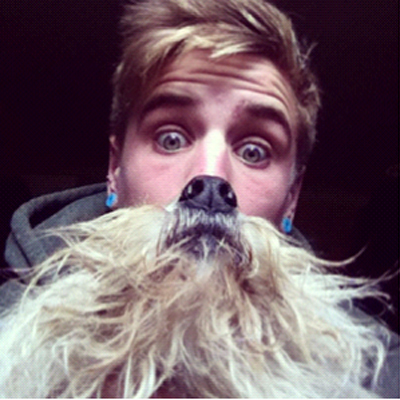
Enter dog bearding, a response to the popular “cat beard” photo meme that involves taking a photo of yourself with your dog. But this isn’t your regular run-of-the-mill “selfie”: the dog-bearding trend involves using the dog’s nose and chin to lend the appearance of having a beard. The result is a hilarious mashup of human and dog that is guaranteed to make you giggle.
Although cats and their humans were first to make the bearding trend famous a couple of years ago, the photo fad is still alive and well on the Internet. If you search Instagram with the hashtags #dogbeard and #dogbearding, you’ll find close to 8,000 photos of people sporting sweet dog beards. Every breed from Miniature Schnauzers toPomeranians are getting in on the bearded selfie action!
We’ve chosen our top favorite dog-bearding Instagram photos for your dog-beard viewing pleasure. Which one tickles your fancy?
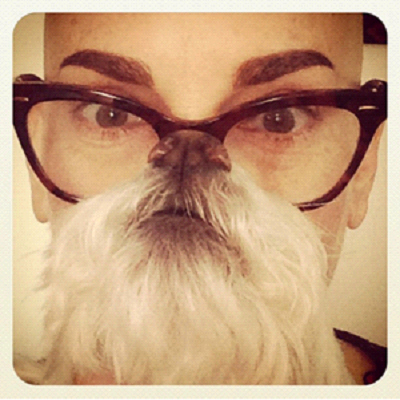
govegandotnet/Instagram
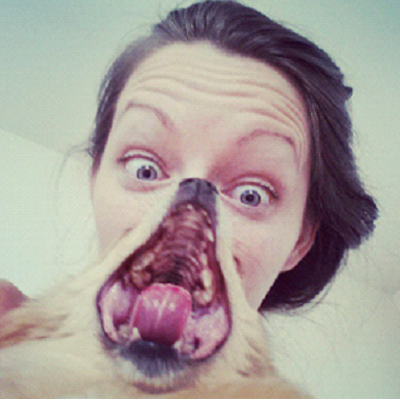
prystupa/Instagram
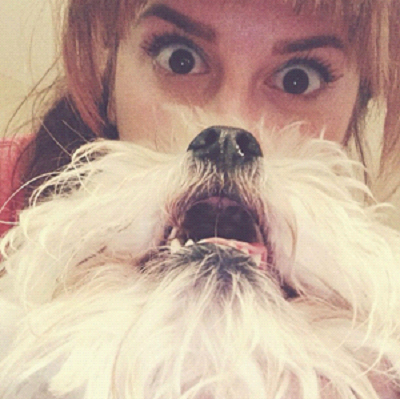
kaltastic/Instagram
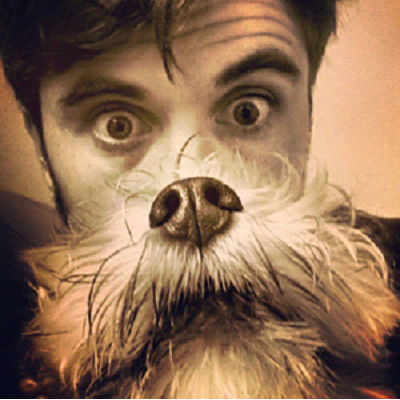
tom19/Instagram

ellenbelle86/Instagram
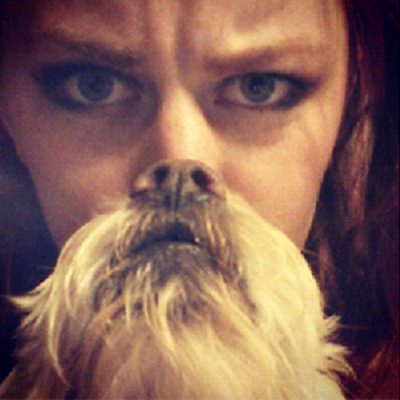
heeethuurrr/Instagram
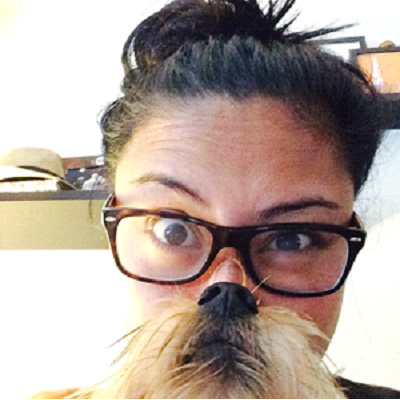
instaprill/Instagram
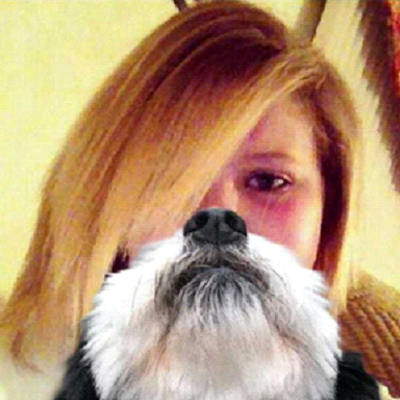
kristen_5_g/Instagram

meganell/Instagram
Help! My Dog Hates Baths
Q: How do I get my dog to stop biting when I try to give her a bath? It’s like she becomes a ferocious attack dog. – Jason S.
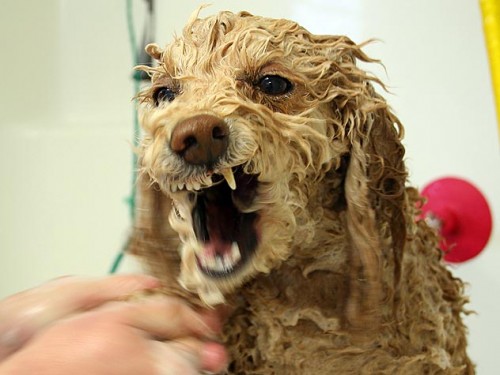
Practice having her in the tub, if that is her bathing spot, with no water running at first. Running water can be scary for dogs, especially with a high-pressure faucet.
Put down an inexpensive rubber bath mat so she doesn’t slip (slipping can add to her nervousness).
Have her on leash and have a helper gently hold her as you let her lick from a sterilized bone (such as those made by Gimborn) stuffed with a creamy food like cream cheese or peanut butter. Gently brush her as she works on the bone.
Keep practicing this in short sessions until she is calm.
Once your dog is calm in the tub, introduce water by taking a container of warm water gently pouring it on one of your dog’s feet.
Gradually increase the length of time in the tub and the amount of water used until you can give her a full bath.
Dog Breeds With Loose Skin
Loose Skin, Tough Background
He may have the look of a dopey and adorable pooch, but the shar-pei’s tough guy history explains exactly why he’s got loose skin. The shar-pei was bred for fighting and his loose skin protected him in two ways. It’s tough, bristled texture deadened the impact of bites and the loose folds enabled him to move about, even if another dog had a good grip on his skin. Modern shar-peis can have somewhat exaggerated skin folds, which affect them negatively in a number of ways. They are more prone to skin infections and in extreme cases, the heavy folds can impede their vision.
Neapolitan Mastiff: Big Skin, No Bite
The Neapolitan mastiff may look fearsome, but it’s been a long time since this gentle giant was used for guarding and protection work. His deep, loose folds give him the distinctive look of a dog wearing a jacket several sizes too big, but like the shar-pei, those wrinkles had a purpose. If called upon to protect people or livestock, his loose skin would reduce his chances of suffering injury from a bite.
Scent-Tracking Skinfolds
Like the Neapolitan mastiff and shar-pei, the bloodhound’s loose skin has an important purpose and if you’re ever on the run from the law, you might just find out about it. His famous scent-tracking abilities wouldn’t be what they are without those loose folds around his jaw and neck. While this pooch patrols the ground for scent, his skin folds capture scent that he’s missed, enabling him to double-check his work and find what he’s looking for.
Bulldog’s Bullbaiting History
Bulldogs have a flattened face because they descend from breeds used for bullbaiting. Those breeds benefited from having a flat face because it enabled them to grip onto their prey while breathing clearly. Today’s bulldog carries the legacy of those dark days, his wrinkled jowls a reminder of his ancestry. Although they serve no practical purpose, those sloppy, wrinkled chops sure are cute. However, there’s also a downside. His skin folds are a haven for infection.
Frenchy’s Wrinkles Are a Fashion Statement
The French bulldog has a shared ancestry with the bulldog and also carries the wrinkly legacy of days gone by. However, his loose skin is also a product of human desire. Many breeders seek to exaggerate the trait of wrinkled skin to give their dogs a distinctive appearance. The French bulldog’s head and shoulder wrinkles should be moderate, but some examples of the breed have excessively loose skin.





